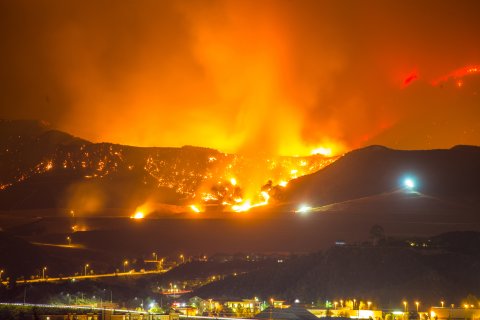
Human Health Impacts of Climate Change
Human Health Impacts of Climate Change
Climate change can affect our health in many ways, including more intense heat waves and wildfires, and worsening the impacts of air pollution. For over a decade, OEHHA has conducted studies on health impacts of climate change, in collaboration with a wide range of academic, state, and nonprofit partners. This page provides links to these scientific publications.
OEHHA studies have focused on the health impacts of climate change in the general population, and identified high-risk, vulnerable population subgroups, for example, the elderly, children, people with existing health conditions, pregnant individuals, people who live in coastal areas who are less acclimated to heat, and people from disadvantaged communities. Our findings highlight disparities in climate change’s impacts and help California get public health information and other resources to the most vulnerable communities.
OEHHA also investigates the health impacts of wildfires. We identified increased adverse health outcomes, like respiratory and cardiovascular diseases, after wildfire smoke exposure. Some of our studies also indicate that the co-exposure of heat and wildfire smoke could pose an increased risk to human health. Our research indicates a need for improved health mitigation strategies during wildfire events. It also helps inform air pollution guidance recommendations.
Health Effects of Heat Exposure
Heat waves, as well as high ambient temperatures that do not get recorded as heat waves, appear to increase mortality.
Also, increased ambient temperatures have been linked to increased hospitalization and emergency room (ER) admissions for many outcomes, including dehydration and heat illness as well as intestinal infection, acute renal failure, diabetes, hypotension, cardiac dysrhythmia, ischemic heart disease, and even mental health issues.
Further, high ambient temperature is associated with adverse birth outcomes such as preterm delivery, stillbirth, and term low birth weight. Greater risks were observed for mothers who were younger, Black, Hispanic, underweight, smoked, consumed alcohol during pregnancy, or had pre-existing health conditions. These impacts on public health are expected to worsen with projected future increases in temperature.
OEHHA has other resources that inform actions to protect Californians’ health from the impacts of heat. Learn more about:
- CalHeatScore, a tool to raise public awareness about dangerous heat waves affecting the state.
- Children’s Environmental Health Center and Air and Climate Epidemiology section with fact sheets with helpful tips for pregnant people and kids to stay safe when it’s hot out.
OEHHA’s publications on the health effects of heat exposure are listed below.
Heat and Mortality
- High ambient temperature and mortality: a review of epidemiologic studies from 2001 to 2008
- Temperature and mortality in nine California counties (2008)
- Mortality effect of the July 2006 California heat wave (2009)
- Heat waves and cause-specific mortality at all ages in California (2011)
- High ambient temperature and mortality in California: exploring the roles of age, disease, and mortality displacement (2011)
- Temperature and infant deaths in California (2015)
Heat and Morbidity
- Temperature and hospital admissions in nine California counties (2010)
- Temperature and emergency room visits in California (2012)
- Temperature and subclinical cardiovascular biomarkers (2017)
- Temperature and mental health-related emergency room visits in California (2018)
- Temperature and hepatobiliary and renal hospitalizations in California, 1999 to 2009 (2019)
- Health impacts of future changes in temperature in California (2011)
- Heat waves and human health in California from 1999 to 2009 (2014)
- Ambient temperature and added heat wave effects on hospitalizations in California from 1999 to 2009 (2017)
- The health burden of fall, winter and spring extreme heat events in Southern California and contribution of Santa Ana winds (2019)
- Spatial variation in the joint effect of heat waves and ozone on respiratory hospitalizations in California (2021)
Heat and Birth Outcomes
- Air pollution and heat exposure with preterm birth, low birth weight, and stillbirth in the US: a systematic review (2020)
- Temperature and preterm delivery: 1999-2006 (2010)
- Temperature and preterm delivery: 1995-2009 (2017)
- Extreme heat episodes and risk of preterm birth in California, 2005-2013 (2020)
- Temperature and term low birth weight in California (2018)
- Temperature and stillbirth (2016)
- Temperature and pre-eclampsia (2017)
- The impact of maternal factors on the association between temperature and preterm delivery (2017)
- Overview of risks to pregnant persons and their offspring (2023)
- Adverse effects of temperature on perinatal and pregnancy outcomes: what we don’t know (2023)
- Impacts of heat and wildfire on preterm birth (2024)
Wildfire Smoke Exposure and Health Effects
Wildfire smoke exposure is associated with not only respiratory disease and asthma but also cardiovascular impacts and mental health impacts, for example, schizophrenia. Pregnant individuals have higher risks of pre-term birth during co-occurring heat and wildfire smoke events.
- Wildfire smoke events and emergency department visits in California, 2016-2019 (2023)
- Wildfire particulate matter emissions on respiratory and cardiovascular health in California (2022)
- Impacts of fine particulate matter and cause-specific morbidity during the 2017 North San Francisco Bay wildfires (2021)
- Wildfire smoke and COVID-19 case fatality ratios (2022)
- Wildfire smoke and respiratory health in California at the zip code level: uncovering the disproportionate impacts of differential fine particles composition (2023)
- Impacts of heat and wildfire on preterm birth (2024)
- A novel ensemble-based statistical approach to estimate wildfire-specific PM2.5 (2023)
Additional OEHHA work related to wildfires can be found on the OEHHA Wildfires website.
Climate Change and Infectious Diseases
As the warm season extends and weather patterns shift, viruses become more active and have increased opportunities to spread, leading to a rise in the incidence and prevalence of certain infectious diseases.


